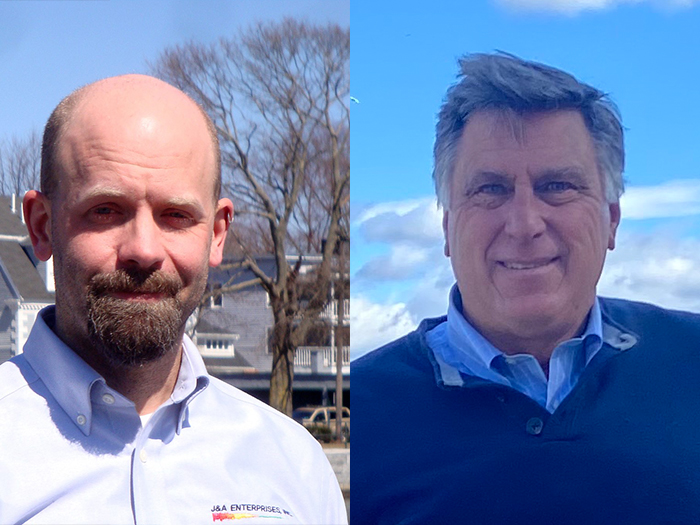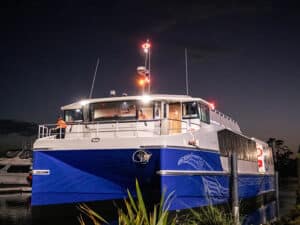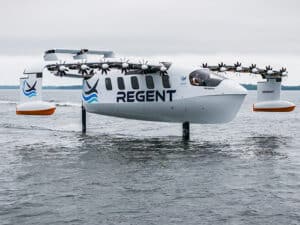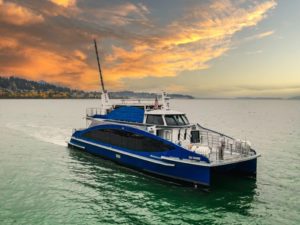
Q&A: 10 Minutes with Soundown and J&A Enterprises
Written by Marine Log Staff
Kaolin Kinsey (left) and Chris Murray (right)
[SPONSORED CONTENT]: Two Salem, Mass., companies are teaming up to lend their expertise to the ferry industry in the way of noise and vibration control: J&A Enterprises Inc., an engineering firm that specializes in noise and vibration control of marine craft, and Soundown Corporation, which focuses on supplying noise and vibration control materials and hardware.
As a platinum sponsor of Marine Log’s upcoming FERRIES 2021 conference, we talked to Kaolin Kinsey, senior engineer at J&A Enterprises Inc., and Chris Murray, sales manager for Soundown Corporation, about the work the companies have done over the years, their long-term relationship, and what you should know about noise and vibration control while building a ferry.
Marine Log (ML): Can you give an overview of J&A Enterprises and Soundown for our readers so they can know more about the companies’ capabilities and expertise?
Kaolin Kinsey (KK): Certainly. We often describe J&A Enterprises and Soundown as “sister” companies for noise and vibration control focused on the marine industry. The companies are under the same ownership and highly collaborative, but functionally independent. J&A offers engineering consulting, while Soundown is a supplier and manufacturer of noise and vibration control products.
At J&A our engineers are involved at all stages of projects, from advising on noise and vibration requirements for the technical specification, to calculating noise and vibration predictions. We develop details for control treatments and check during construction that they are done correctly, and we do measurement sea trials to verify that the ship meets requirements. J&A also does a lot of diagnostic measurement and engineering when an existing vessel comes down with a noise or vibration issue.
Christopher Murray (CM): As Kaolin mentions, there is a relationship between the two companies, but we have different focuses in our approach to noise and vibration control. Soundown’s focus is on the products, materials, and applied technology needed by boat builders and shipyards to achieve the results their projects require.
We provide the deep technical understanding of the materials and their applications, which is needed to take an engineered solution or specification from the design phase to a finished construction. In general, one could say J&A provides the understanding and details of what needs to be done, and Soundown provides the products, materials, and support to properly execute those details.
ML: Can you describe the process and what is involved in meeting noise and vibration requirements when bidding and building a ferry or other commercial craft?
CM: The upfront engineering work is the most important aspect of achieving a noise spec or building a quiet boat. Once engineering is completed Soundown can interpret the details in a way that turns them into a very straightforward bill of materials. We also draw on extensive experience with similar projects to provide practical application support that aligns with shipyard capabilities and work processes. This helps turn the engineering and material specs into easily buildable details.
KK: Yes, especially in a new build this is the case, to start the process with good noise control design collaboration between the Owners, Builder, and suppliers like Soundown. Ideally this starts as the vessel’s noise spec is being worked out, defining noise and vibration limits that are appropriate for the ferry’s intended use, with passenger and crew comfort the objective but at limits that are practical to meet in construction. Usually a Builder will include a budget for noise control consulting in their bid for a project, so that they’ll meet the specification requirements.
It’s during the detail design stage that the whats, wheres, and hows of the treatments are defined, and then during the construction phase we make periodic inspection visits to check that the noise and vibration treatments are installed correctly and in the right locations, per the design and materials selection. Then, finally, when the ship is about ready for delivery we conduct sea trials surveys to verify that noise and vibration requirements are met, or if the limits are exceeded somewhere we work to diagnose the issue and come up with ways of correcting it.
ML: What are the biggest challenges you typically encounter in a ferry construction project?
KK: There are certain types of noise sources, for example propeller noise, that can be very challenging to design effective treatments for, but something else I find challenging—and I think Chris can speak to this as well—is coming up with treatments to meet the noise and vibration goals of the project while also making sure to meet other requirements like cost, weight, fire safety, being practical to build, and sometimes we run up against constraints on which materials and treatments are allowed by Regulatory.
CM: We have product groups, which are tailored to performance, weight, and cost ranges. The challenges come when trying to balance all three areas in a way that achieves the project requirements and maintains appropriate budgets. Sometimes we need to be innovative in how to approach the build ups of materials to assist shipyards in gaining labor, fabrication, and installation efficiencies in order to offset higher cost materials sometimes required by regulations or specifications.
ML: Can you give a couple of good pieces of advice for designers, owners, and shipyards when considering a quiet ferry project?
KK: The farther along a project is, the more difficult it can be to have good options for practical noise control treatments. If you need to meet noise and vibration requirements, get noise control experts on the project as early in the process as possible, even in the preliminary design stages.
Early on, if, say, a hull vibration problem is predicted then there can be time to tweak the design to try to correct it. But if the structural design is already fully mature then modifications might no longer be feasible or would take an incredible amount of effort. Similar for HVAC fan noise, foundations for mechanical equipment, diesel exhausts and so on. So, my advice would be to engage your friendly noise and vibration control consultant from the onset.
CM: At the risk of being redundant, I also have to say the earlier the better when addressing noise and vibration. In many cases material and hardware for noise control take up valuable space in a vessel. Understanding what solutions are needed to reach design targets is essential in the allocation of space and weight in the project. Managing the real estate required to achieve quiet as early as possible in the process always leads to the best results.




